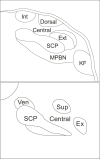A role for the lateral parabrachial nucleus in cardiovascular function and fluid homeostasis
- PMID: 25477821
- PMCID: PMC4235290
- DOI: 10.3389/fphys.2014.00436
A role for the lateral parabrachial nucleus in cardiovascular function and fluid homeostasis
Abstract
The lateral parabrachial nucleus (LPBN) is located in an anatomical position that enables it to perform a critical role in relaying signals related to the regulation of fluid and electrolyte intake and cardiovascular function from the brainstem to the forebrain. Early neuroanatomical studies have described the topographic organization of blood pressure sensitive neurons and functional studies have demonstrated a major role for the LPBN in regulating cardiovascular function, including blood pressure, in response to hemorrhages, and hypovolemia. In addition, inactivation of the LPBN induces overdrinking of water in response to a range of dipsogenic treatments primarily, but not exclusively, those associated with endogenous centrally acting angiotensin II. Moreover, treatments that typically cause water intake stimulate salt intake under some circumstances particularly when serotonin receptors in the LPBN are blocked. This review explores the expanding body of evidence that underlies the complex neural network within the LPBN influencing salt appetite, thirst and the regulation of blood pressure. Importantly understanding the interactions among neurons in the LPBN that affect fluid balance and cardiovascular control may be critical to unraveling the mechanisms responsible for hypertension.
Keywords: blood pressure; cardiovascular responses; lateral parabrachial nucleus; serotonin; sodium appetite; thirst.
Figures

References
-
- Asnar D. S., Roncari C. F., De Luca L. A., Jr., de Paula P. M., Colombari D. S., Menani J. V. (2013). Involvement of central cholinergic mechanisms on sodium intake induced by gabaergic activation of the lateral parabrachial nucleus. Neurosci. Lett. 534, 188–192. 10.1016/j.neulet.2012.11.042 - DOI - PubMed
-
- Blair M. L., Jaworski R. L., Want A., Piekut D. T. (2001). Parabrachial nucleus modulates cardiovascular responses to blood loss. Am. J. Physiol. Regul. Integr. Comp. Physiol. 280, R1141–R1148. - PubMed
Publication types
LinkOut - more resources
Full Text Sources
Other Literature Sources

